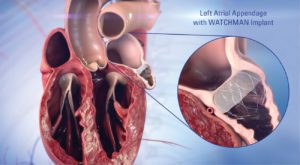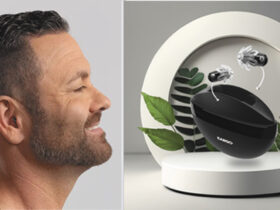By Cynthia Beth Gamble, ARNP-C, AACC

On April 4, 2019, Caroline Lackey celebrated her 90th birthday with a cardiac checkup.
Forty-five days earlier, the motorcycling great-grandmother had received a heart implant to help prevent a stroke and eliminate her need for blood-
thinners. After taking the medication for a dozen years, the redheaded spitfire suffered from anemia and severe bruising.
“I would wake up in the morning and look like I had been beaten,” said the Englewood resident. “I was taking iron pills and was still anemic. I knew that I could have a stroke very easily. God knows I don’t want a stroke.”
In February 2019, Lackey received the WATCHMAN implant in a procedure at Venice Regional Bayfront Health. The device, which is implanted during a minimally invasive surgical procedure, offers an alternative to the lifelong use of blood-thinners for people with a common cause of irregular heartbeat that can lead to stroke.
How WATCHMAN Works
The WATCHMAN permanent heart implant device was designed for patients with atrial fibrillation not caused by a heart valve problem (also known as non-valvular atrial fibrillation). Atrial fibrillation, or AFib, affects the heart’s ability to pump blood normally. This can cause blood to pool in an area of the heart called the left atrial appendage, or LAA. There, blood cells can stick together and form a clot. When a blood clot escapes from the LAA and travels to another part of the body, it can cut off the blood supply to the brain, causing a stroke.
In people with AFib not caused by a heart valve problem, more than 90 percent of stroke-causing clots that come from the heart are formed in the LAA. Closing off this part of the heart is an effective way to reduce stroke risk.
The WATCHMAN implant fits into the LAA. It’s designed to permanently close off the appendage. This will keep blood from flowing into the appendage and prevent blood clots from developing in this area. WATCHMAN is about the size of a quarter and is made from very light and compact materials commonly used in many other medical implants. WATCHMAN is implanted into the heart in a one-time procedure. It’s a permanent device that doesn’t have to be replaced and can’t be seen outside the body.
The WATCHMAN implant effectively reduces the risk of stroke, without the risk of bleeding that can come with the long-term use of warfarin (the most common blood thinner). WATCHMAN also can eliminate the regular blood tests and food-and-drink restrictions that come with warfarin. (Warfarin is also known as Coumadin®.)
In a clinical trial, nine out of 10 people were able to stop taking warfarin just 45 days after the WATCHMAN procedure.
Dilip Mathew, M.D., FACC, FHRS, leads the WATCHMAN team at Venice Regional. He and his partner, Antonio Moretta, M.D., FHRS, who also performs the procedure, are board-certified and fellowship-trained in cardiology and cardiac electrophysiology. Their Sarasota-based practice, Heart Rhythm Consultants P.A., focuses on managing heart rhythm disorders.
To implant WATCHMAN, Dr. Mathew makes a small cut in the patient’s groin and inserts a narrow tube, as is done in a standard cardiac catheterization or stent procedure. The surgeon then guides WATCHMAN into the LAA. The procedure is done under general anesthesia and takes about an hour. Patients stay in the hospital overnight and typically leave the next day.
Before receiving the WATCHMAN device, patients must meet certain criteria for stroke risk and bleeding risk. Because any medical procedure poses risks, patients should not be considered for WATCHMAN if they are doing well and expect to continue doing well on blood thinners.
Lackey doesn’t take blood-thinner medication anymore, although she will take a platelet-reducing
drug for a time and will take aspirin the rest of her life.
“There is really nothing to it,” said the great-
grandmother about her WATCHMAN surgery. “The nurses and doctors (at Venice Regional) are fantastic, and I went home the next day.”
For information about AFib and the WATCHMAN procedure, call 941-486-6790.
Cynthia Beth Gamble, ARNP-C, AACC, coordinates the structural heart program at Venice Regional Bayfront Health.
Venice Regional Bayfront Health
Call 941-486-6790 or visit VeniceRegional.com







